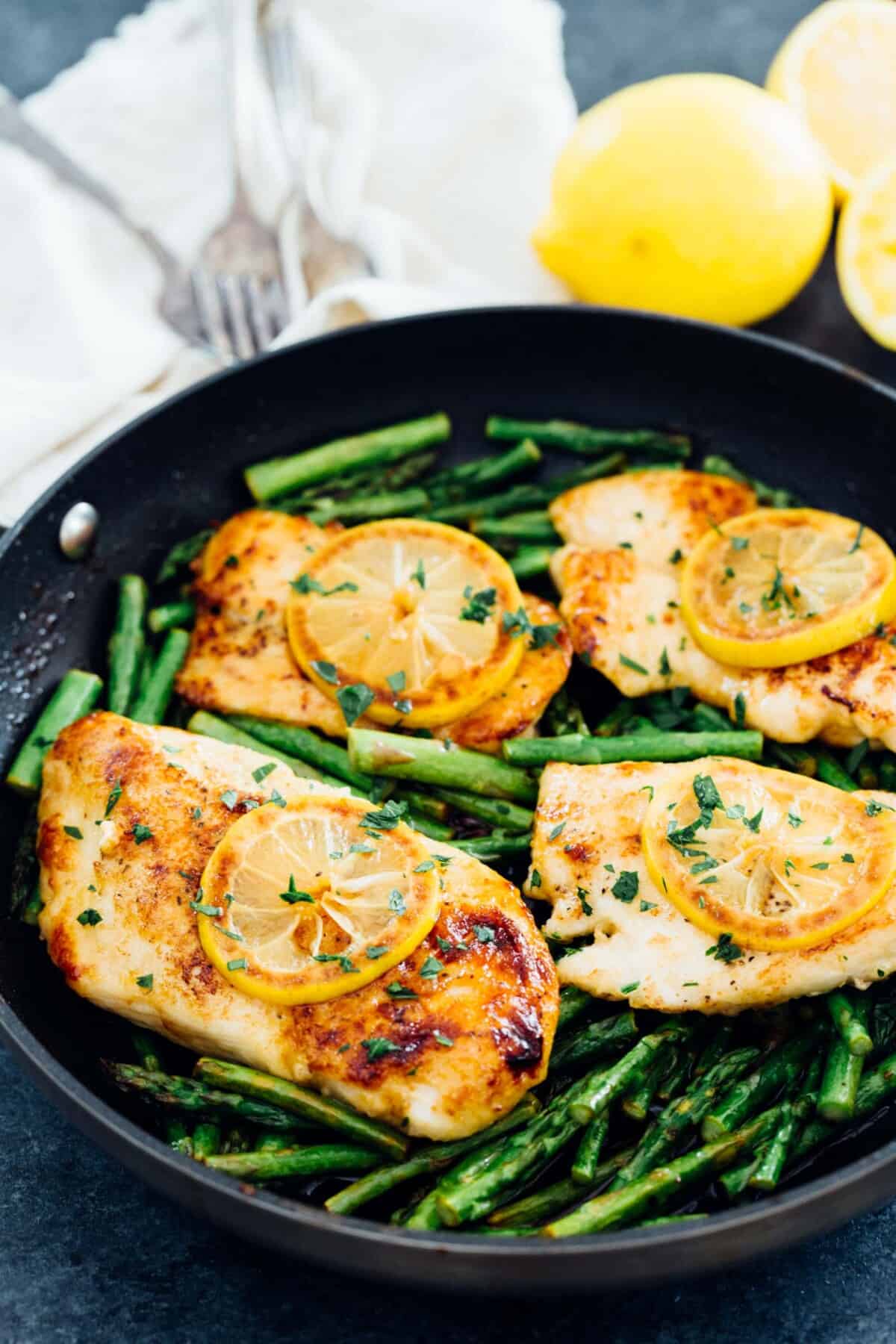
Ingredients:
4 T softened butter, preferably unsalted
2 T honey
juice of 1 lemon, divided
¼ C cornstarch or flour
salt and pepper
1 pound boneless, skinless chicken breasts
large bunch of asparagus, about 3/4 – 1 pound, trimmed*
*To trim asparagus, cut off the bottom inch or two with a knife or simply break it off with your hands. You may also use a vegetable peeler to peel off the tough outer skin of the lower few inches.
Instructions:
In a small bowl, whisk together softened butter, honey, and juice of 1/2 the lemon. Set aside.
In a pie plate, plate or plastic bag, combine cornstarch/flour, salt and pepper. Add chicken and coat it evenly with the seasoned flour. Dust off excess flour.
In a large skillet over medium-high heat, melt honey butter mixture then add the chicken and brown on one side, about 5-7 minutes. Repeat on the other side and cook until chicken has cooked through and internal temperature reaches 165 degrees with a meat thermometer.
Add the asparagus to the skillet and cook until just tender. Squeeze the remainder 1/2 of the lemon onto the cooked dish.
Optional: Slice another lemon and after the chicken and asparagus has finished cooking, "cook" the lemon to use as a garnish as shown in the photo above provided by
For more asparagus ideas, check out the Pioneer Woman's 30 Best Asparagus Recipes to Celebrate the Spring Veggie. Read some Asparagus Facts after the story below!
If you would like to be notified when we share new recipes, be sure to scroll to the bottom, provide your email address, check the box confirming you are not a robot, click on a few photos to prove it and click subscribe! You will then receive an email after each new post. Remember, we're always looking for new recipes, so keep sending them to ecopact@fspa.org!
Story:
This Lent and Easter has led me to pray, read and reflect about individual conversion and service. Saint Francis on his death bed, encouraged us to ask: “What is mine to do?” What communities of service call and guide me to act? I am definitely passionate and active about feeding the hungry. I can cook from scratch, eat seasonally, garden, compost, help end food insecurity by cooking for unsheltered brothers and sisters, offering to coach people in the kitchen, encouraging donations to Food Pantries and Food Banks. I also know that charity is not enough. When it comes to feeding the hungry, how can I become more of an advocate for systemic change and transformation?
The Resurrection season confirms these questions in me. Jesus’ rising changes everything! No one should be bound by suffering and death. To me, that means one act at a time. It means acting in community with others toward changing systems that condones hunger, war, economic insecurity, racism and environmental injustice. How do we act with others and learn, to see with new eyes, to wake up to what is possible? Below are some resources that encourage me. I'm learning. Let us encourage each other to bring the power of new life, forgiveness and systemic change that lives out the resurrection of Jesus Christ!
Bread for the World an advocacy group for addressing world hunger, tells us advocacy with Congress is valuable, stating: "Federal nutrition programs provide roughly 10 times as much food assistance as private churches and charities combined."
Pax Christi USA an advocacy group for peacemakers shares an April 6th article called Easter calls us to ensure the survival of humanity by Joseph Nagle, OFM. Pax Christi International peace movement website shares how to Pray on Sunday, Act on Monday.
NETWORK Advocates for Justice Inspired by Catholic Sisters, is a ministry well-versed in addressing White Supremacy and other ills that call for healing changes at the national and global level. Their website states: "The Catholic Social Justice principle of participation calls us to inform ourselves about the issues of the day, to engage in serious conversations with our neighbors about our nation’s future, and to learn to listen to different perspectives with empathy. This responsibility to participate means each person must be equipped with the resources needed to do so."
Franciscan Justice Circles, supported by the Franciscan Action Network, offers ways to gather with others near you in person or virtually to work for justice. "Our times need grassroots, Franciscan inspired advocacy and action connecting Franciscan-hearted individuals through prayer, action, and advocacy in cities across the country." There is one called "Driftless Region FSC - Western Wisconsin/SE Minnesota".
Feeding Tomorrow, a documentary by Oliver and Simon English, directly addresses the food system and ways to transform it. Stream it free on Hoopla (an app from many local public libraries) that provides movies to view for free. You can also rent or buy it on Amazon Prime. Read more at FeedingTomorrow, Starting Today. My dream is to gather people from all walks of life to watch the film and later, to gather at round tables to talk about it's impact and actions to take together! More on “Feeding Tomorrow” soon.
Asparagus Facts:
• Asparagus is one of only 3 perennial vegetables that thrive in the upper Midwest, along with rhubarb and horseradish, a yearly reminder of hope and resurrection!
• Asparagus seeds or more developed “crowns” take 2-3 years to produce fruit. Patience, trust and care, gardeners! It can even be sown in pastures and harvested from among the forage plants.
• The edible stems or “spears” arise from underground. Asparagus season lasts about 6-8 weeks, early May to late June in MN and WI, so corresponds to spring and even the Easter season most years! After that, we let the leaves in the form of beautiful “ferns” grow to strengthen the plant for the next cycle of new life. Even the ferns require some care to flourish. Info above courtesy of University of Minnesota Extension.
• In summer, fall and winter through April, some fresh asparagus at most stores is from CA, but most is from Mexico or Peru. This trend is tied to rising water prices in the US, the passage of NAFTA, and the unintended effects of the US War on Drugs. Boston Organics tells us that Peruvian farmers who once grew coca for cocaine were subsidized by the U.S to switch to asparagus. Soon Del Monte moved its processing plant there to take advantage of lower prices.
• Soon fresh, tasty local spears can be found at your favorite farmer’s market or co-op..
• Seasonal eaters don’t shy away from sort of “gorging” on seasonal asparagus. It can be roasted, blanched, pan seared, added to soup, risotto, pasta dishes, an open face egg or ham sandwich, quiche or served as an appetizer wrapped in bacon or Italian ham. The recipe below is a one skillet meal with a built-in side of asparagus! What is your favorite spring vegetable recipe to repeat while it is in season?



